Territorial evolution of Germany

| Territorial evolution of Germany in the 20th century |
|---|
The territorial evolution of Germany in this article include all changes in the modern territory of
The period of Nazi rule from the early 1930s through the end of the Second World War brought significant territorial losses for the country. Nazi Germany initially expanded the country's territory dramatically and conquered most of Europe, though not all areas were added to Germany officially. However, the Nazi plan for the near future was the establishment of a Greater Germanic Reich[3][4] including most of Europe. The Nazi regime eventually collapsed, and the four Allies occupied Germany.
Nazi annexations from the time of its annexation of Austria on 13 March 1938 were annulled while the
The western part of Germany was unified as the
Background
German settlement in Central and Eastern Europe
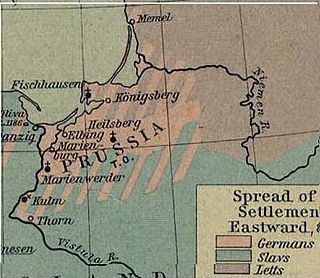
Part of the motivation behind the territorial changes is based on historical events in the Eastern and Central Europe. Migrations to the East that took place over more than a millennium led to pockets of Germans living throughout Central and Eastern Europe as far east as Russia. The existence of these enclaves was sometimes used by German nationalists, such as the Nazis, to justify territorial claims.
The rise of European nationalism
The territorial changes of Germany after World War II can be interpreted in the context of the evolution of global nationalism and European nationalism.
The latter half of the 19th century and the first half of the 20th century saw the rise of nationalism in Europe. Previously, a country consisted largely of whatever peoples lived on the land that was under the dominion of a particular ruler. As principalities and kingdoms grew through conquest and marriage, a ruler could wind up with many different ethnicities under his dominion.
The concept of nationalism was based on the idea of a "people" who shared a common bond through race, religion, language and culture. Furthermore, nationalism asserted that each "people" had a right to its own state. Thus, much of European history in the latter half of the 19th century and the first half of the 20th century can be understood as efforts to realign national boundaries with this concept of "one people, one state". Many interior conflicts were a result of more or less pressurising citizens of alternative ethnicities and/or other native languages to assimilate to the ethnicity dominant in the state. Switzerland was the exception, lacking a common native language.
Much conflict would arise when one nation asserted territorial rights to land outside its borders on the basis of an ethnic bond with the people living on the land. Another source of conflict arose when a group of people who constituted a minority in one nation would seek to secede from the nation either to form an independent nation or join another nation with whom they felt stronger ties. Yet another source of conflict was the desire of some nations to expel people from territory within its borders because people did not share a common bond with the majority of people of that nation.
History
Formation of the German Empire
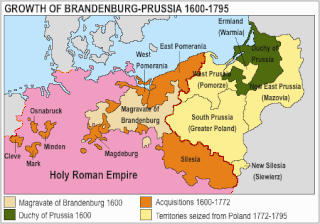
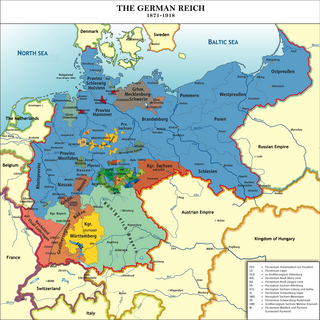
Prussia
Following the capture of
North German Confederation
Following the
Heligoland
World War I
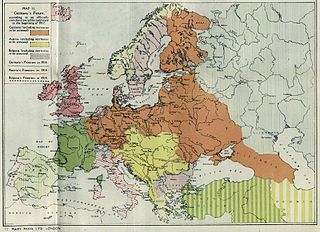
Brest-Litovsk
As part of the
Most of these territories were in effect ceded to the German Empire, intended to become economically dependent on and politically closely tied to that empire under different German kings and dukes.
Regarding the ceded territories, the treaty stated that "Germany and Austria-Hungary intend to determine the future fate of these territories in agreement with their population" with few other effects than the appointment of German rulers to the new thrones of Finland, Latvia, Lithuania, and
Territorial changes after World War I
Treaty of Versailles
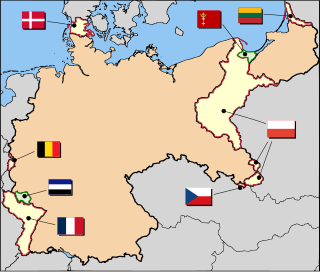
The provisions of the Treaty of Versailles at the end of World War I obliged Germany to cede some territory to other countries. Besides the loss of the German colonial empire, the territories Germany lost were:
- plebisciteas a precondition to armistice (i.e. and therefore not as a clause of the Treaty of Versailles) with effect from the date of the armistice (11 November 1918), (14,522 km2 or 5,607 sq mi, 1,815,000 inhabitants (1905)).
- Schleswig Plebiscite(3,984 km2 or 1,538 sq mi, 163,600 inhabitants (1920)).
- Most of the Grenzmark Posen-West Prussia. A sizeable German population still remained in the areas ceded to Poland, however.
- The Hlučín Region of Upper Silesia to Czechoslovakia (316 or 333 km², 49,000 inhabitants).
- Upper Silesia plebiscitein which 60% had voted in favor of remaining German and 40% wanted all of Upper Silesia to become Polish. The vote was designed to provide guidance on how to divide the area, and most of the areas voting for Poland were separated from Germany.
- The area of Eupen-Malmedy to Belgium, along with the Vennbahn railway line (which created six German enclaves within Belgian territory).
- The northern part of East Prussia as without a vote.
- The area of Danzig route) in East Prussiato Poland (492 km2 or 190 sq mi).
- An area from the eastern part of West Prussia and the southern part of East Prussia East Prussian plebiscite); the majority of the Slavic Masuriansvoted to remain part of Germany.
- The Saar areawas to be under the control of the League of Nations for 15 years, after which a vote between France and Germany would be held to decide which country it would belong to. During this time, the region's coal was given to France.
- The port of Danzig (now Gdańsk, Poland) along the delta of the Vistula became the Free City of Danzig under the League of Nations. (1,893 km2 or 731 sq mi, 408,000 inhabitants (1929)), 90% Germans.
- Germany acknowledges and will respect strictly the independence of Austria.
Sudetenland
The Sudeten Germans had attempted to prevent the German language border areas of former
Silesian uprisings
The Silesian Uprisings (Polish: Powstania śląskie) were a series of three armed uprisings (1919–1921) of Poles in the Upper Silesia region against Weimar Republic in order to separate the region (where in some parts Poles constituted a majority) from Germany and join it with the Second Polish Republic.
Interbellum
Territorial claims of German nationalists
By World War I, there were isolated groups of Germans or so-called
German nationalists used the existence of large German minorities in other countries as a basis for territorial claims. Many of the propaganda themes of the Nazi regime against Czechoslovakia and Poland claimed that the ethnic Germans (Volksdeutsche) in those territories were persecuted.
The Nazis negotiated a number of population transfers with Joseph Stalin and others with Benito Mussolini so that both Germany and the other country would increase their ethnic homogeneity. However, these population transfers were not sufficient to appease the demands of the Nazis. The Heim ins Reich rhetoric of the Nazis over the continued disjoint status of enclaves such as Danzig and East Prussia was an agitating factor in the politics leading up to World War II, and is considered by many to be among the major causes of Nazi aggressiveness and thus the war. Adolf Hitler used these issues as a pretext for waging wars of aggression against Czechoslovakia and Poland.
Rhineland
On 7 March 1936, Hitler sent a small expeditionary force into the demilitarized Rhineland. This was a clear violation of the Treaty of Versailles (1919, official end of World War I), and as such, France and Britain were within their rights, via the Treaty, to oust the German forces. British public opinion blocked any use of military force, thus preventing French action, as they were internally divided and would not act without British support.
Saar region
In 1933, a considerable number of anti-
On 17 January 1935, the territory's re-union with Germany was approved by the
As the new
.Anschluss
The Allies were, on paper, committed to upholding the terms of the Treaty of Versailles, which specifically prohibited the union of Germany and post-war Austria (a German-speaking country). This notwithstanding, the Anschluss was among the first major steps in the Austrian-born Adolf Hitler's long-desired creation of an empire including German-speaking lands and territories Germany had lost after World War I.
The events of 12 March 1938, marked the culmination of historical cross-national pressures to unify the German populations of Austria and Germany under one nation. However, the 1938 Anschluss, regardless of its popularity, was enacted by Germany. Earlier, Hitler's Germany had provided support for the
Although Schuschnigg expected Austria to vote in favour of maintaining autonomy, a well-planned
Czechoslovakia
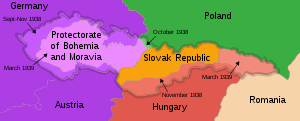
Sudetenland
On 29 September 1938, Adolf Hitler, Neville Chamberlain, Benito Mussolini and Édouard Daladier signed the Munich Agreement. The Czechoslovak government capitulated on September 30 and reluctantly agreed to abide by the agreement. The settlement gave Germany the Sudetenland starting October 10, and de facto control over the rest of Czechoslovakia as long as Hitler promised to go no further.
Hitler and Chamberlain signed an additional resolution determining to resolve all future disputes between Germany and the United Kingdom through peaceful means. This is often confused with the Four-Power Munich Agreement itself, not least because most photographs of Chamberlain's return show him waving the paper containing the resolution, not the Munich Agreement itself.
Without
Invasion of the rest of Czechoslovakia
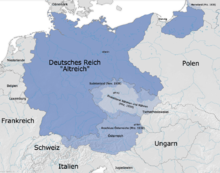
On 13 March 1939, Nazi armies entered
Prime Minister Chamberlain felt betrayed by the Nazi seizure of Czechoslovakia, realising his policy of
Memel Territory
By late 1938, Lithuania had lost control over the situation in the Memel Territory. In the early hours of 23 March 1939, after a political ultimatum had made a Lithuanian delegation travel to Berlin, the Lithuanian Minister of Foreign Affairs Juozas Urbšys and his German counterpart Joachim von Ribbentrop signed the Treaty of the Cession of the Memel Territory to Germany in exchange for a Lithuanian Free Zone in the port of Memel, using the facilities erected in previous years.
World War II
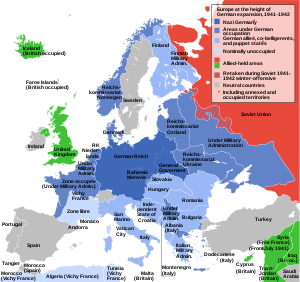

Poland
After
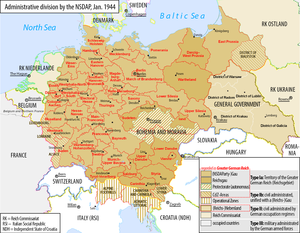
Two decrees by Adolf Hitler (8 October and 12 October 1939) provided for the division of the annexed areas of Poland into the following administrative units:
- Poznań Voivodeship, most of the Łódź Voivodeship, five counties of the Pomeranian Voivodeship, and the Działdowo/Soldau County of the Warsaw Voivodeship;
- Reichsgau Danzig-West Prussia (initially Reichsgau West Prussia), which consisted of the remaining area of the Pomeranian Voivodeship and the Free City of Danzig;
- Ciechanów District (Regierungsbezirk Zichenau), consisting of the five northern counties of Warsaw Voivodeship (Płock, Płońsk, Sierpc, Ciechanów, and Mława), which became a part of East Prussia;
- Katowice District (Regierungsbezirk Kattowitz), or unofficially East Upper Silesia (Ost-Oberschlesien), which included Sosnowiec, Będzin, Chrzanów, and Zawiercie Counties, and parts of Olkusz and Żywiec Counties.
These territories had an area of 94,000 km2 (36,000 sq mi) and a population of 10,000,000 people. The remainder of the Polish territory was annexed by the Soviet Union (c. 52%; see Molotov–Ribbentrop Pact) or made into the German-controlled General Government occupation zone.
After the
Alsace-Lorraine
After the invasion of France in 1940, Germany annexed the départements of Bas-Rhin, Haut-Rhin, and Moselle (Alsace-Lorraine). The German government never negotiated or declared a formal annexation, however, in order to preserve the possibility of an agreement with the West.[citation needed]
Eupen and Malmedy
See Eupen-Malmedy
Luxembourg
Luxembourg was invaded and occupied by German Forces in June 1940. It was formally annexed to Germany in August 1942.
Parts of Yugoslavia
From:
South Tyrol
South Tyrol was
Recognition
The fact there were the areas that had been incorporated into Nazi Germany since the Anschluss were repudiated in the Berlin Declaration of 5 June 1945 by the four victorious Allies who also officially abolished Nazi Germany and started to represent post-war Germany with the Declaration, new Nazi areas since the Anschluss were already considered the "annexations" by the Allies before in the war and were therefore non-issues in the post-war Germany.
Territorial changes after the German defeat in World War II
With the Allied Berlin Declaration of 6 June 1945 and Potsdam Agreement of 2 August 1945, German annexations which began with the German annexation of Austria were annulled and Germany also lost the traditionally ethnic German eastern region[8] prior to the German annexation of Austria. Saarland separated from Allied occupied Germany to become a country under French protection on 17 December 1947, in 1949 the Federal Republic of Germany (FRG) and later the German Democratic Republic (GDR) were born, leading to Germany being split into two countries; present-day German territories were formed when the Saarland became part of the FRG on 1 January 1957 and the territories of the GDR became part of the FRG on 3 October 1990 (German borders also had other changes but tiny).

As it became evident that the Allies were going to defeat Nazi Germany decisively, the question arose as to how to redraw the borders of Central and Eastern European countries after the war. In the context of those decisions, the problem arose of what to do about ethnic minorities within the redrawn borders. The territorial changes at the end of World War II were part of negotiated agreements between the victorious Allies to redraw national borders and arrange for deportation of all Germans that were east of the Oder–Neisse line. The Allies occupied Germany, but the Western allies and Soviet Union formed separate governments covering specific parts of Germany (West Germany and East Germany). The two Germanies reunified in 1990.
The Yalta Conference
The final decision to move Poland's boundary westward was made by the
Originally, Germany was to retain Stettin while the Poles were to annex
Key points of the meeting that are relevant to the territorial changes of Germany are as follows:
- There was an agreement that the priority would be the unconditional surrender of Nazi Germany. After the war, Germany would be split into four occupied zones, with a quadripartite occupation of Berlin as well, prior to unification of Germany.
- Stalin agreed to let France have the fourth occupation zone in Germany and Austria, carved out from the British and American zones. France would also be granted a seat in the Allied Control Council.
- Germany would undergo demilitarization and denazification.
- The status of Poland was discussed, but was complicated by the fact that Poland was at this time under the control of the Polish Provisional Government of National Unity and to have democratic elections. This effectively excluded the Polish government-in-exilethat had evacuated in 1939.
- The Polish eastern border would follow the Curzon Line, and Poland would receive substantial territorial compensation in the west from Germany, although the exact border was to be determined at a later time.
- A "Committee on Dismemberment of Germany" was to be set up. The purpose was to decide whether Germany was to be divided into several nations, and if so, what borders and inter-relationships the new German states were to have.
The Potsdam Conference
At the
At the end of the conference, the Three Heads of Government agreed on the following actions:
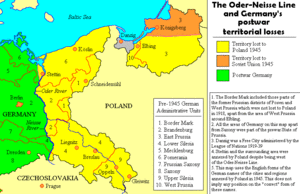
- Issuance of a statement of aims of the occupation of Germany by the Allies: The industrial plans for Germany)
- Division of Germany and Austria respectively into four occupation zones (earlier agreed in principle at Yalta), and the similar division of each's capital, Berlin and Vienna, into four and five sectors (one quadripartite sector), respectively.
- Reversion of all German annexations in Europe after 1937, among these were Sudetenland, Alsace-Lorraine, Austria, the westmost parts of Poland, and others.
- Germany's eastern border was to be shifted westwards to the Landsberg an der Wartheand so on.
- Hungary, Poland, Romania, and Yugoslavia. France, which had not participated in the Potsdam conference, took its liberties to dismiss this point and therefore refused to absorb any expellees in its zone of occupation.[9]
Finalization of the Polish-German border
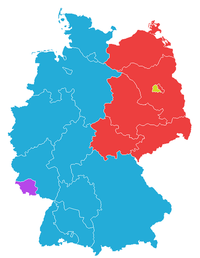
The problem with the status of these territories was that the concluding document of the Potsdam Conference in 1945 was not a legally binding treaty, but a memorandum between the USSR, the US and the UK. It regulated the issue of the eastern German border, which was to be the Oder–Neisse line, but the final article of the memorandum said that the final decisions concerning Germany were to be subject to a separate peace treaty.
Based upon this interpretation of the Potsdam Agreement, the
Between 1970 and 1990, the West German political establishment gradually recognised the "
Luxembourg
Belgium
The "Working Party on Provisional Adjustments to the Western Frontiers of Germany" approved in 1949 the provisional transfer of 20 km2 (7.7 sq mi) containing 500 inhabitants to Belgium:[10]
- Bildchen (returned in 1956)
- Lichtenbusch (returned in 1956)
- Fringshaus — roads between Roetgen and Fringshaus, Fringshaus and Lammersdorf, Fringshaus and Konzen (first two returned in 1956)
- Leykoul (eastern part returned in 1956)
- Elsenborn
- Losheim(only the village returned in 1956)
- Hemmeres (returned in 1956)
As part of the 1956 treaty, in exchange for the territory ceded by Germany, Belgium ceded to Germany its territory north of the Fringshaus roads and bounded by the Vennbahn. The detached territory, in 1956 containing 704 inhabitants including refugees, was, prior to its 1956 dissolution and partition between West Germany and Belgium, ruled as an independent territory by Belgian Army Major General Paul Bolle, who enjoyed dictatorial powers.[11]
Netherlands
Despite the more extensive annexation proposals of the
Starting in March 1957, West Germany negotiated with the Netherlands for the return of these areas. The negotiations led to an agreement (German: Vertrag vom 8. April 1960 zwischen der Bundesrepublik Deutschland und dem Königreich der Niederlande zur Regelung von Grenzfragen und anderen zwischen beiden Ländern bestehenden Problemen; short: Ausgleichsvertrag, i.e. treaty of settlement[12]) made in The Hague on 8 April 1960, in which Germany agreed to pay DEM 280 million for the return of Elten, Selfkant, and Suderwick, as Wiedergutmachung.
The territory was returned to Germany on 1 August 1963, except for one small hill (about 3 km2, 1.2 sq mi) near
France
Starting on 16 February 1946 France de facto disentangled the Saar area and the separate
Poland
In 1949, there was modest exchange of territory between the Polish People's Republic and the German Democratic Republic (GDR). What is now the1 B 104/B 113 road junction at Linken, Mecklenburg-Western Pomerania to the immediate west of the Polish town of Lubieszyn was transferred from Poland to the GDR in return for a narrow strip of land lying directly on the west side of the road that connected the settlements of Linki and Buk. This move necessitated the creation of a new road linking Lubieszyn to Linki and Buk that mirrored the new shape of the border.[13] In 1951, a small area of land on Usedom Island (Polish: Uznam) was ceded from the German Democratic Republic (Eastern Germany) to Poland. The water pumping station for Świnoujście (German: Swinemünde) lies on that land and was therefore handed over to Poland. In return, a similarly-sized area north of Mescherin, including the village of Staffelde (Polish: Staw), was transferred from Poland to the German Democratic Republic.[14] In 1968, East Germany and Poland signed a treaty for the Baltic continental shelf delimitation. On May 22, 1989, East Germany and Poland completed the delimitation of their territorial waters in the Gulf of Szczecin.
See also
References
- ^ a b c Timeline: Germany - BBC News
- ^ Authaler, Caroline (2019). "Das völkerrechtliche Ende des deutschen Kolonialreichs. Globale Neuordnung und transnationale Debatten in den 1920er Jahren und ihre Nachwirkungen". Aus Politik und Zeitgeschichte. 69 (40–42): 5 f. Archived from the original on 4 April 2022. Retrieved 4 April 2022.
- ^ Cowie, Stuart (ndg) "To what extent was the outbreak of World War Two, a consequence of failures in British Foreign Policy?" Academia.edu
- ^ Barry, Max (ndg) "Großgermanisches Reich der Deutschen Nation" NationStates
- ^ Rearmament and the European Defense Community Library of Congress Country Studies
- ISBN 0-520-02775-2.
- ISBN 830804140X.
- ^ see for example msn encarta Archived 26 May 2011 at the Wayback Machine: "diejenigen Gebiete des Deutschen Reiches innerhalb der deutschen Grenzen von 1937", Meyers Lexikon online Archived 26 January 2009 at the Wayback Machine: "die Teile des ehemaligen deutschen Reichsgebietes zwischen der Oder-Neiße-Linie im Westen und der Reichsgrenze von 1937 im Osten".
- ^ Cf. the report "Vor 50 Jahren: Der 15. April 1950. Vertriebene finden eine neue Heimat in Rheinland-Pfalz" Archived 31 July 2013 at the Wayback Machine of the Central Archive of the State of Rhineland-Palatinate on the first expellees arriving in that state in 1950 to be resettled from other German states.
- ^ International Boundary Study Office of the Geographer Bureau of Intelligence and Research
- Time Magazine, 8 October 1956.
- ^ Cf. Bundesgesetzblatt (Federal Law Gazette), part III, no. 181-1.
- ISBN 83-7241-272-3(in Polish).
- ^ "Marking of borders/Oznakowanie granic". Museum of Polish Border Formation/Muzeum Polskich Formacji Granicznych. 2020. Retrieved 21 April 2020.
External links
 Media related to Territorial evolution of Germany at Wikimedia Commons
Media related to Territorial evolution of Germany at Wikimedia Commons
